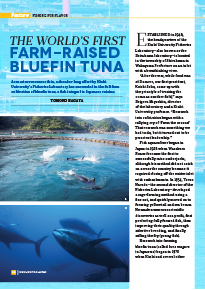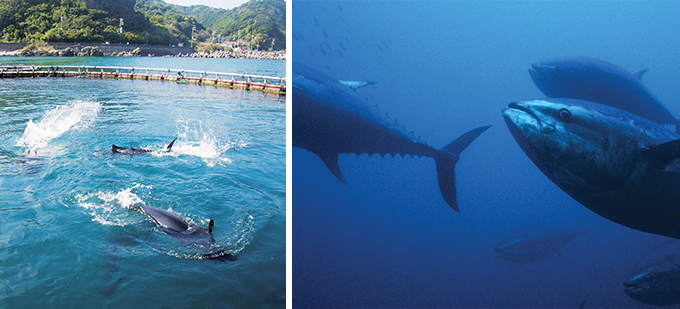Home > Highlighting JAPAN >Highlighting Japan July 2015>Fishing for Flavor
Highlighting JAPAN

Fishing for Flavor
The World’s First
Farm-raised Bluefin Tuna
As marine resources thin, a decades-long effort by Kinki University’s Fisheries Laboratory has succeeded in the full farm cultivation of bluefin tuna, a fish integral to Japanese cuisine.

Established in 1948, the headquarters of the Kinki University Fisheries Laboratory—also known as the Shirahama laboratory—is located in the township of Shirahama in Wakayama Prefecture on an inlet with a breathtaking view.
“After the war, while food was still scarce, our first president, Koichi Seko, came up with the principle of treating the ocean as another field,” says Shigeru Miyashita, director of the laboratory and a Kinki University professor. “Research into cultivation began with a rallying cry of ‘Farm the oceans!’ That research was something we had to do, but it turned out to be prescient leadership.”
Fish aquaculture began in Japan in 1928 when Wasaburo Noami became the first to successfully raise amberjacks, although his method did not catch on across the country because it required closing off the entire inlet with embankments. In 1954, Teruo Harada—the second director of the Fisheries Laboratory—developed a cage-farming method using a fine net, and quickly moved on to farming yellowtail and sea bream. He made numerous scientific discoveries as well as a profit, first perfecting fully farmed fish, then improving their quality through selective breeding, and finally selling the fry (young fish).
Research into farming bluefin tuna (called kuro maguro in Japanese) began in 1970 when Kinki and several other universities and public research facilities engaged in a three-year project initiated by Japan’s Fisheries Agency. The project met with difficulties, however, including the youngest fish dying or being eaten within months, and other research institutes were forced to withdraw due to budget and time restraints. Only Kinki’s Fisheries Laboratory, which was self-sustaining from the start, was able to continue its research. Professor Miyashita attributes the drive behind the continued research not just to the fact that the laboratory was able to keep funds rolling in, but also to Teruo Harada’s belief that cultivating fry for use in fish farming was necessary for environmental sustainability.
However, the bluefin tuna is among the largest of migratory fish, and the process was not nearly as smooth as with the yellowtail or sea bream. Most of the fry died. The ones that survived cannibalized each other as they grew, or rammed the walls of the tank and died. Their scales are small and extremely fragile, so they can die just from being handled or getting caught in nets.
Even worse, the tuna did not spawn for a total of eleven years. Just as people began voicing their doubts about continuing the program, however, the water rose to the optimum spawning temperature in 1994, and the fish began reproducing at last. In 2002, the Shirahama laboratory became the first in the world to succeed in fully farming bluefin tuna—incubating and raising a fish to adulthood, taking eggs from that adult, and incubating them to begin the cycle anew—thirty-two years after the research began.
Survival rates from egg to full adulthood have gone from 0.0016 percent to 1 percent today. That number may seem small, but Miyashita says, “If these rates were seen in the wild, the oceans would be overrun with tuna.” These bluefin tuna have been dubbed “Kindai tuna” after the university. Researchers are currently searching for a way to industrialize the cultivation process, most crucially raising good fish to stable adulthood. Furthermore, relying on wild fish for feed limits the stabilization of production, and research on a vegetable-based feed without fish powder is proceeding at breakneck speed.
Kinki University’s fishery techniques are now recognized worldwide, and in addition to academic exchanges with universities in Malaysia and other nations, the Shirahama laboratory has dispatched technicians to countries such as Canada and Australia. Further down the line, overseas exports are being considered to meet the rising demand created by the Japanese food boom. The plan is to triple the total production from the current 80 tons per year to 240 tons (equal to around six thousand fish) by 2020 through technical cooperation with industry.
Communicating the benefits of farm-raised fish and the high-level skills required for fishery production—along with planning the revitalization of the fishing industry—are key policy measures both globally and domestically. Within Japan, the number of meals that include fish is decreasing as the diet of the Japanese people diversifies, and the idea that farmed fish don’t taste good still prevails. With those things in mind, Kinki’s Fisheries Laboratory opened restaurants specializing in farmed fish in Osaka’s Umeda and Tokyo’s Ginza districts, to much fanfare and long lines. Meanwhile, major fish producers introduced the first fully farmed tuna to regular supermarkets in June 2015.
“Although fish prices across Japan are falling and the fishing industry is faltering, I am not pessimistic,” Miyashita states confidently. “Farmed fish are indispensable precisely because we are so close to exhausting our marine resources. Together with the fishery industry peers that accompanied me on this journey, we will continue to develop our techniques.”
© 2009 Cabinet Office, Government of Japan






